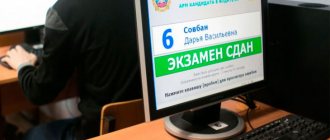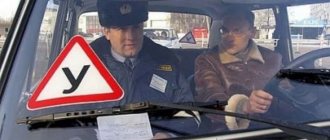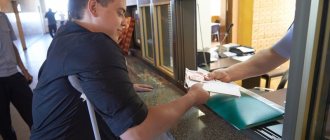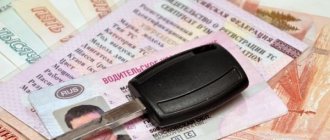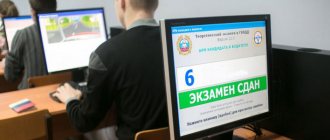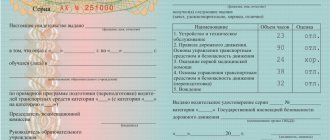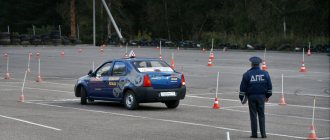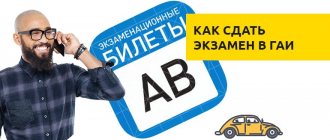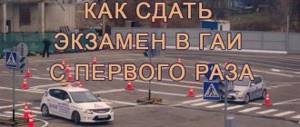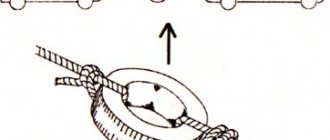So, from April 1, those who seek to obtain a driver's license will have to take a practical exam under the new rules. If previously it was divided into two stages - the so-called “site” and “city”, then from tomorrow there will be no more “site”: it will merge with the “city” - and all driving skills will be tested in one test. How will all this actually happen? We have prepared answers to the most frequently asked questions in connection with the upcoming changes.
So, it means that now there will be no “platform” at all?
Yes, there will no longer be a “platform” as a separate stage of the practical exam. However, all the exercises that were performed on it will remain . They will be tested in city traffic conditions. But not only…
In fact, the use of the autodrome during the practical exam is also permitted by the new regulations of the Ministry of Internal Affairs . As the department explained, if there are no conditions for testing a maneuver on the road network, the test can be carried out on a race track.
However, in any case, it will not be like before, when only after one practical stage you get access to the next one. The practical exam will be one and the same : you get behind the wheel and demonstrate your skills both from the “site” and from the “city”.
City driving - traffic police exam
Nowadays, when cities are overcrowded with motor vehicles, few people manage to pass the driving test without errors the first time. Basically, those who have no doubts, those who are determined and who do not pay attention to what the people around them can pass can pass.
Each driving school informs its students where and along what route the driving test will take place. You need to take advantage of this and study the route in advance. If you can’t travel along the route with a driving instructor, then at least sit in the passenger seat with someone to travel along the given routes, remember the location and types of signs, and other details regarding the 2021 traffic rules.
Advice such as taking a sedative before an exam does not help, but only harms. These are useless recommendations. On the contrary, you need to activate your brain, not be sleepy and lethargic. You can activate your brain by drinking tea or coffee and performing a simple physical exercise - squats. This will ensure blood flow and drowsiness will go away.
So, useful tips on how to pass the traffic police exam in the city:
- If there is still time before the test, do not skip driving. Ride, ride and ride again, with an instructor, throughout the city, and not just on one street.
- Learn all the rules. To pass a theoretical exam, the most effective method is this method of memorization - first solve all the first questions of all tickets, then all the second questions, then the third, etc. Since questions by number are related to the same topic, this is the most effective way. To pass driving, it is not enough to know the theory perfectly, you need to be able to see and apply them.
- Learn the traps from the traffic police inspector who takes the exam. We'll talk about this below.
- Wear comfortable clothes. If you are used to a sporty style, then this is what you should wear. If someone is used to always wearing a suit, it’s better for him to come in one.
- From my own experience, I can say that being among the first to pass the exam is easier. Maybe it’s just a coincidence, or maybe the instructor wants to fail more in the afternoon.
- Do not follow all the instructions of the instructor, think first.
So now the same parking lot will have to be rented out on busy city streets clogged with cars?!
Not certainly in that way. To test skills from the “site”, the Ministry of Internal Affairs regulations recommend using sections of roads with low traffic and dead ends, preferably outside residential buildings . In other words, to the center of Moscow with the instruction “Look for a parking space parallel to the sidewalk!” newcomers should definitely not be sent.
What is also important is that they will be able to check the implementation of the “garage” and “diagonal” only where there is appropriate marking for this . If there are no markings, then it turns out that the examiner has no right to demand a “parking” maneuver.
Mistakes when taking the city exam
The most common mistakes made when taking the exam for a city traffic police inspector are mistakes when making turns and U-turns. Due to increased nervousness, if, for example, drivers of neighboring cars honk, some forget to turn on the turn signal and yield to cars that have the right of way.
Of course, it is extremely rare to see a traffic controller during a driving test, but you must know all his gestures.
List of popular driving mistakes:
- Turn signals. For failure to turn on the turn signal, the instructor, according to the table of error points, writes down 3 penalty points. When changing lanes, turning, turning around, going around an obstacle and leaving your lane - all this requires informing other road users about your maneuvers.
- Mirrors. Not only do you need to look in the mirrors when maneuvering, even when driving straight, you also need to monitor the situation around the car.
- Turn left and turn around. In fulfillment of this instruction from the instructor, many are sent to retake. You must clearly know where to turn and turn, and how to do it. In driving practice before the test, it is advisable to drive through difficult areas of the city to gain good experience. It will be difficult to avoid difficult passages and turns all the time.
- A priority. If another car has priority, that is, you must give way to it and you do not, then this is a serious mistake. If there are no priority signs, then the right-hand rule should be applied. Give way to buses starting from stops. Yield during turns and other situations stipulated by the current traffic rules.
- Pedestrians.
- Always slow down and slow down before pedestrian crossings, even if there is no one on them. Maybe a few meters before the zebra, a pedestrian will step onto the road. Therefore, in order to have time to stop and let pedestrians pass, you should drive through pedestrian crossings at low speed.
- Drifting into the oncoming lane while turning. A common mistake among beginners. When turning left, you can enter any lane. But, if there are no markings and it is not clear after the turn whether this lane is for oncoming traffic or for passing cars, then it is better to take the far right lane.
- Exiting the stop line. It would seem that this is a simple mistake and they won’t get a lot of credit for crossing the stop line without stopping, but that’s not the case. For this, the instructor writes down 5 penalty points.
- Avoiding obstacles. There may be this option: you are driving in the far right lane and a car drives halfway out of the yard and blocks your lane. The best solution here would be to give way to an exiting car rather than enter the adjacent lane and go around it. These unnecessary changes are of no use during the exam.
- Entering an intersection during a traffic jam on a further section of the road in your direction. This year, 2021, from April 28, a new marking “Waffle Iron” is in effect (clause 1.26 of the Russian Traffic Regulations), which says that if there is traffic behind the intersection, then it is prohibited to enter the intersection, even if the traffic light is green, because you will be standing at an intersection and interfere with cars traveling perpendicularly when their traffic light turns green. For this violation, 3 points are assigned. In normal cases, for driving onto a waffle marking in the event of a traffic jam in front, a fine of 1000 rubles is charged. There is also a 50% discount on this fine if paid within 20 days.
Are all the elements of the “site” being transferred to the city?
No, so-called You won’t have to rent out a “snake” in the city .
The remaining elements, in general, will remain : parking when driving in reverse with a turn of 90 degrees (“garage”), parking parallel to the sidewalk when driving in reverse (“diagonal”), as well as when moving forward, stopping and starting on an uphill slope and on a descent (“overpass”), turning in a limited space, and for trucks and road trains - reversing and parking for loading/unloading, coupling and uncoupling a trailer with a tractor.
And they say that the calculation of penalty points will also change!
The principle of calculating penalty points itself will remain the same. Errors, as before, will be divided into several groups , depending on which they will also be awarded a different number of penalty points.
However, the severity of some of these errors will indeed change .
So, from April 1, using a mobile phone while driving and not fastening a seat belt will become serious violations : if a driver candidate is caught in at least one of them, the test will be stopped immediately. Although until recently, such errors were awarded three penalty points, with which (in the absence of other penalty points) the test could still continue.
In addition, some other errors will be assessed differently . For example, for failure to comply with road marking requirements, which was previously assessed at three points, from April 1, they will be awarded a little less - two points. But on the other hand, the same amount, two points, will be given for violating the rules for positioning a vehicle on the roadway or for driving at too low a speed, although previously such errors were punished with only one point.
And this is all because the old rules for assigning two penalty points for mistakes did not provide for them at all : for violations they gave five points, three points or one point. However, from April 1, the gradation will be as follows: three penalty points, two points or one point, and after certain violations the exam will be stopped altogether (however, this is the same as awarding five points).
How to learn to drive a car with manual transmission
Cars with manual transmission are the most difficult to drive. If a beginner learns to drive a car with a manual transmission, then driving a car with another type of transmission will not be a problem. The main difficulty that a beginner faces when driving a car with a manual transmission is the inability to use the clutch pedal and not knowing when and how to change gears.
Pedals location
A common mistake of the greenest beginner is ignorance of how the gas, brake and clutch pedals of a car with a manual transmission are located. The clutch pedal is always located on the left, the gas pedal (accelerator) on the right. The brake is always centrally located. The gas and brake pedals are always controlled with the right foot, the left one should rest on the clutch pedal or on the resting area.
How to start a car and drive away
Before you start your car, you need to make sure of two things:
- The parking brake is on, also known as the handbrake (in the raised position);
- neutral gear is engaged.
Many experienced drivers leave a parked car in first gear. Thus, they are insured against malfunction of the handbrake - the car cannot spontaneously start moving in a parked state if it is in gear. However, for beginners this practice is unacceptable - if you forget that the car is in gear, then immediately after starting the engine it will start moving.
Reference
There is a solution to this problem - at the same time as starting, you need to depress the clutch and brake pedal. In this case, the movement of the car will be blocked, even if it is in gear and not using the handbrake.
You also need to start it up correctly:
- First, the key inserted into the socket must be turned to an intermediate position - in this case, the lights on the dashboard light up and the fuel pump starts working;
- in this position you need to wait 3-4 seconds;
- then you need to turn the key to the extreme right position, starting the starter.
If within 5-8 seconds the spinning starter is unable to start the engine, then you need to return the key to the intermediate position, otherwise you can fill the spark plugs with gasoline.
The next stage is the beginning of movement. To get moving, you need:
- fully depress the clutch (press it all the way);
- then begin to gradually let it go.
If you perform such manipulations, the car will begin to drive smoothly “on the clutch”. Already while driving you should:
- fully depress the clutch again;
- engage first gear;
- Gradually pressing the gas, you need to smoothly release the clutch.
How to properly depress the clutch
This moment is one of the most difficult for a beginner. Many of them stall because they release the clutch too quickly. But you can’t hold the clutch pedal for too long, as you can burn it out. Finding a balance in this matter is not an easy task.
Beginner drivers need to remember two things:
- To change gears you must always depress the clutch;
- When braking, the brake pedal is always pressed simultaneously with the clutch pedal.
The first time, novice drivers cannot cope with the pedals, so they either overstay their foot on the pedal, then release it too quickly, or completely forget to depress the clutch. Over time, this will pass and the driver will control the clutch pedal in automatic mode.
How to change gears
The gear shift pattern varies between cars and depends on the number of speeds - now you can find cars that have from 5 to 8 gears in the range. Usually the diagram is depicted on the handle of the lever; it must be remembered.
Reference
Beginners often get confused and engage the wrong gear - 4th instead of 2nd, 5th instead of 3rd. Usually the car reacts sharply to this - the engine speed drops, a nod occurs, etc. There is no need to be afraid of such a situation - even experienced drivers can mistakenly select the wrong gear. The main thing is to quickly understand your mistake and shift into a lower gear.
When to change gears
Correctly shifting the gear of a manual transmission is one of the main difficulties that newbies face behind the wheel. First gear is almost always used only to start moving; after the car has started moving, you should switch to second gear. The higher the speed gained, the higher the gear should be engaged.
When changing gears, you need to focus on the number of engine revolutions. Most modern engines have an operating range between 2.5 and 3.5 thousand rpm. If the tachometer needle drops below this number, you need to engage a lower gear. If the arrow approaches or exceeds this mark, you need to turn on the increased one. You can understand that you need to change speed by the sound of the engine. The higher it is, the more revolutions the engine makes.
Attention
You cannot start the engine into the red zone of the tachometer - this could result in damage to the engine.
Maintaining the correct ratio of engine speed and gear is one of the main responsibilities of the driver. If the number of revolutions for the current gear is too low, the car will begin to vibrate; if it is too high, the engine will begin to “choke.”
Approximate speed shift table
| Transfer number | Approximate vehicle speed |
| 1st | Up to 20 km/h |
| 2nd | 20-40 km/h |
| 3rd | 40-60 km/h |
| 4th | 60-90 km/h |
| 5th | 90-110 km/h |
| 6th | Over 110 km/h |
Despite the fact that the table gives a rough idea of the speed shift ranges, it is largely arbitrary - all cars behave differently. Some engines are more torquey and responsive, so they allow you to use a wider speed range, while others have narrower gear shift modes. Engine size is also important. The behavior of cars with turbocharging and diesel engines is also different. Therefore, you first need to focus on the tachometer needle and the sound of the running engine - if the tachometer needle approaches the red zone and the engine begins to “howl,” then you need to engage an overdrive gear.
How to turn correctly
It is not advisable to shift the manual transmission lever while turning. However, when cornering, the car's speed and engine speed usually drop, so if the gear is too high, the car begins to vibrate. Usually, beginners are taught to take a turn in “neutral”, and after reaching a straight path they are recommended to engage the gear. In fact, it is not necessary to do this - you can turn in 2nd or 3rd gear. The main thing is that it is turned on in advance, even before entering the arc. The turning process itself can be divided into several segments.
- When approaching an intersection, you need to reduce your speed and engage the appropriate gear.
- Before entering the arc, you need to release the accelerator. During the turn itself, the car must move at a constant speed. You should turn the steering wheel in the direction the car is turning.
- After exiting the arc onto a straight line, you need to straighten the steering wheel, then press the gas pedal and increase the speed.
How to brake and stop correctly using manual mechanics
Putting the brake pedal to the floor is not the best way to stop a car. Such actions are allowed only in case of emergency braking, which prevents an accident. However, many modern cars have very sensitive brake pedals, so newbies often become hesitant when using the brakes.
To stop the car smoothly, you need to perform the following steps sequentially.
- With your left foot you need to fully depress the clutch pedal.
- Place your right foot on the brake pedal and gently press it, gradually increasing the pressure. The speed will begin to gradually decrease.
- When the car has stopped, you need to engage neutral gear and the parking brake.
By the way, will anything change in the theoretical exam?
Not yet. Although the traffic police have had such plans for a long time. The department, for example, is not against increasing the number of questions , and previously they even talked about introducing a point system to evaluate results .
…
We also add that from April 1, in addition to merging the “site” and the “city,” predetermined routes for practical exams will be excluded (a list of streets where tests can be carried out will be approved, but not their sequence), and observers will be given the opportunity to be present during exam in a car , and driver candidates can appeal the results .
The complaint will be considered using audio and video recordings (they must be made without fail), and if it is satisfied, the exam results will be canceled .
Pitfalls when passing the driving test depending on the circumstances
Here are 4 common pitfalls that cause you to fail your city driving test:
- Turn left at the intersection. The instructor said to turn left. The intersection in this case is not regulated (there is no traffic light or traffic controller). You are driving along the main road and come to an intersection, wait and let oncoming cars pass and finish the maneuver (pass the intersection), and at this time people are passing at the pedestrian crossing of the intersection. Stay? But then it will interfere with cars on the main road. Drive? But then there will be a hindrance for pedestrians. This case is typical for a small intersection where the zebra crossing is located right next to the carriageway of the main road. If you find yourself in this situation, then most likely the exam will fail, depending on the instructor. To avoid this situation, when turning left, give way to oncoming cars and wait immediately until the pedestrians leave.
- Uncontrolled intersection or adjacent area. The inspector said to turn left at an unregulated intersection of equivalent roads. The main thing here is not to get confused and not to drive into the yard. It is not always possible to immediately distinguish an intersection from adjacent areas. If you drive through an intersection, you will not pass the exam. If you go into the courtyards, then the exam will not be passed. Therefore, you need to be able to determine whether it is an intersection or not.
- They didn't let a pedestrian pass. While driving, we assessed the situation; there was no one on the zebra crossing, and neither were there any suitable zebra crossings. But when there was about a meter of distance left to the zebra, a pedestrian suddenly appeared. Have time to slow down and stop or pass, since the pedestrian is only walking in another lane. If you don't have time to stop, you won't pass the exam. If you pass, even if a pedestrian is walking in another lane, you will not pass the exam. Therefore, an important rule helps here - reduce your speed in front of pedestrian crossings, even if they are empty.
- Turning into the oncoming lane. If the street is narrow, in a residential area, all two lanes (forward and backward), cars are forced on the right. You have to drive in the opposite direction. The inspector commands: at the intersection, turn left. You entered an intersection from the oncoming lane - you failed the exam. There is an empty area in front of the intersection itself. Immediately behind the last parked car, you need to take your right lane and perform a maneuver from this lane.
